
The Most Effective Guide to Keyword Research
It’s no secret that SEO is the key to Google rankings success. But what’s the key to a strong SEO strategy? Keyword research!
Keyword research is the foundation for your overall content strategy. It determines your topics and themes, your article titles, and ultimately the search rankings you’ll earn.
Here’s the problem: many people — even professional marketers— see keyword research as a simple process that lists focus words and phrases and dumps them as much as possible into blog articles.
But that’s not enough. In fact, lazy keyword stuffing will have a negative impact on your results.
Keyword research — when executed the right way — is a multi-step process that requires time, research, and a strategy behind it. But the ROI you’ll earn from doing it is well worth it.
In the sections that follow, I’ll walk you through the proven keyword research process we use at Marketing Insider Group, including tips and templates you can use to get started.
Quick Takeaways:
- Good keyword research is rooted in understanding buyer intent.
- Creating a brief document helps you clarify your preferences, target audiences, and SEO and content goals.
- Know your existing keyword rankings and those of your competitors.
- Follow best practices for blog article writing to maximize ROI on your keyword research.
- Tracking your monthly SEO progress enables you to capitalize on opportunities and solve problems more quickly.
Understand Your Primary Buyer Intent
Good keyword research is always rooted in buyer intent.
What does that mean? In short, your keywords need to center around what your potential customers search for when they need your solution — not what you assume is most important as a business owner or marketer.
It also needs to align with the specific stage they’re at on the buyer journey. For example: are they ready to buy right now or are they performing their first exploratory search? The keywords and content you target to these two buyer groups should differ.

With that in mind, here’s how I define keyword research:
Keyword research is the process of identifying the words and phrases your target customers search for at each stage of the buyer journey as they seek solutions to their problems.
Key phrase there: solutions to their problems. Buyers are generally looking to solve problems — and they aren’t attached to a single solution for getting it done. Instead, they look for the brand that can best address their pain points and needs.
People most commonly read blogs to learn something new, be entertained or read about the latest news in their industry. To put it simply, people only care about reading something that applies to them.
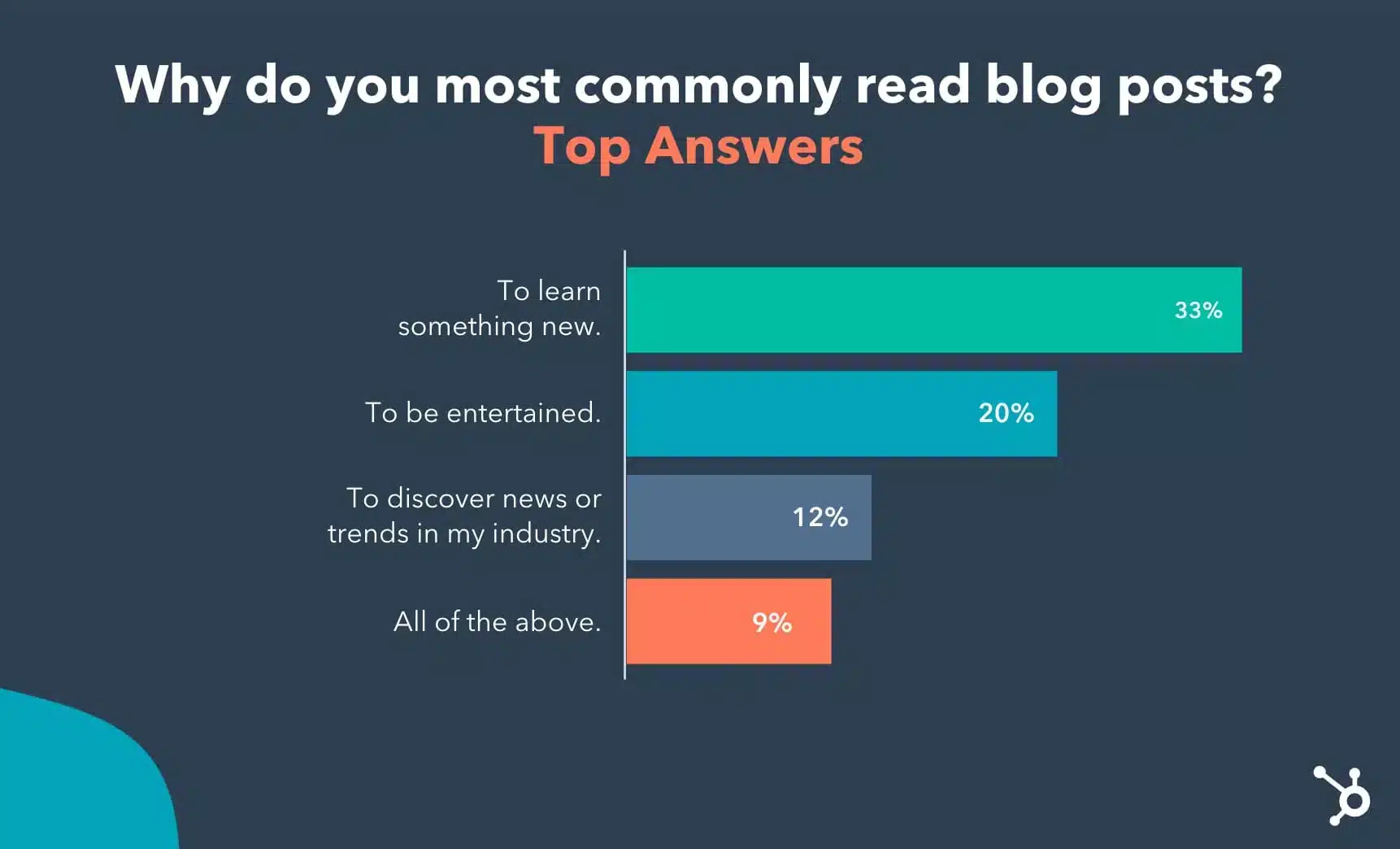
Image Source: HubSpot
When you perform accurate, thorough keyword research to serve as the foundation for great content, you can show customers that you understand them and demonstrate why they should choose your brand over your competitors.
At Marketing Insider Group, we follow a proven 5-step process for keyword research. It starts with documenting important information about your brand’s content goals and it continues well after you start publishing by tracking monthly progress.
Create a Brief
Every MIG client fills out a client brief (see part of it pictured below) that gives us a clear idea of their preferred writing style, brand voice and tone, content goals, and more. We think it’s so important that we even completed a client brief for ourselves. We update it frequently to reflect new goals and keep it fresh.
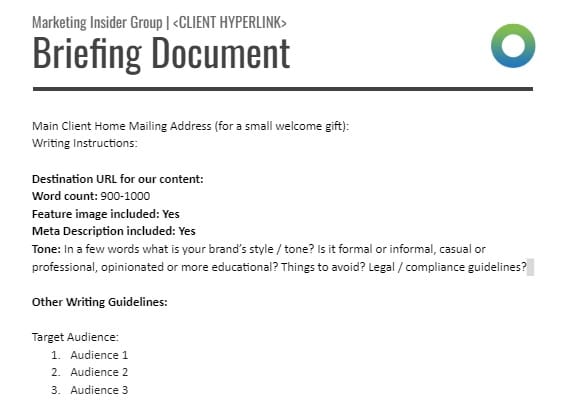
The first step of your keyword research process — whether you’re working with an agency or doing it yourself — should be to create your brand’s brief. Believe me, this is a helpful exercise no matter how well you already know your own brand.
Here’s what to cover in your brief:
- Writing preferences – Word count, tone, and other specifics your writers should know
- Target audiences – Who are you writing for? Use your buyer personas to help with this.
- Competitors – What brands do you compete with for customers and space on SERPs?
- Content themes and pillars – Areas of focus for your keywords and topics
- Examples – Specifics about keywords you wish you ranked for, articles you love, and publishers you read are helpful references for writers.
Once you have your brief completed, take time to reflect on it and consider how it can inform not only your keyword research but your entire content strategy.
Perform Competitive Analysis
Our crucial purpose is to disassemble the competitors’ strategy and find what we’ve missed. In our case, we are talking about the keywords which lead a customer to our project.
So, the actual plan:
- Find direct competitors of the project
- Find and analyze competitors’ leading pages which bring the most traffic
- Find traffic-generating keywords that we’ve missed
I recommend repeating all these steps at least once a month. It’ll help to notice the changes, filter, improve and adapt them to your project in time. Let me walk you through this process using Serpstat. You can just easily use another tool such as Semrush or Ahrefs.
Find your direct competitors
To find your direct competitors you can use SEO tool with “competitor analysis” feature like Serpstat.
Pass to the “SEO Research” section and choose the tool “Competitors.” Then sort the results in descending order by common keywords. The indicator in the column of “common keywords” should be as close as possible to “all keywords” indicator. These domains are our direct competitors.

So, we chose three stores: https://www.bpillow.com/ https://www.mypillow.com/ https://www.downandfeathercompany.com/
Find their top-performing pages
Now we’ll type these domains into Serpstat, use the “Top Pages” tool, sort it in descending order by the potential traffic and select the first 10 perspective pages.
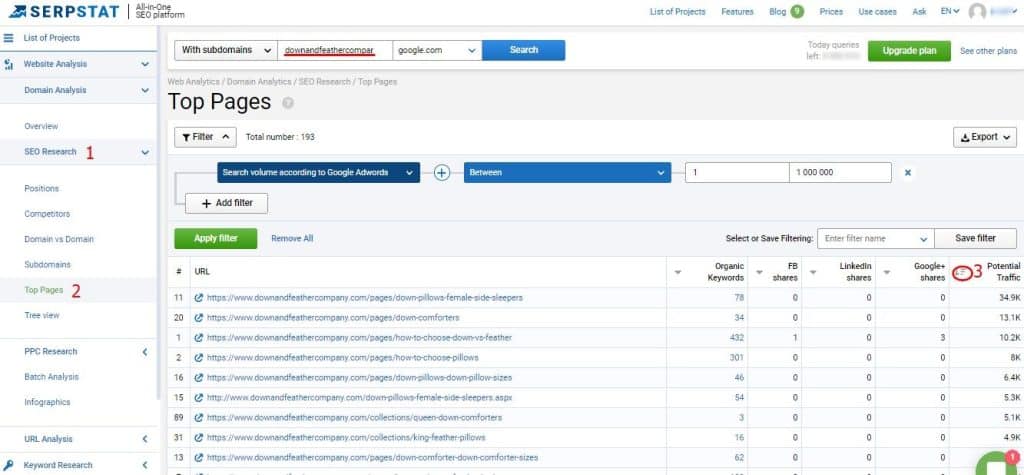
Analyzing these three sites, we can find coincidences in users’ choice. For example, despite the fact that all these sites are commercial, the most popular pages are informative (“how to choose pillow”, “things side slippers need to know” etc.). So, if we’re going to launch such store, we shouldn’t miss this way of customer engagement.
Or if we see that one of these sites offers “pillows for the neck pain” and it’s quite popular there, we should think about adding this product too.
Now we can find out which keywords lead to these pages by clicking on the number in the “organic keywords” column. Thus we can pick a lot of keywords for the bulk in case if we’re launching the same product.
Also, we can compare our site with competitors’ ones by the same product and see which keywords we’ve missed.
Find the gaps in visibility
We need to find out what keywords bring traffic to competitors but not to us, and then check if we use these phrases.
Serpstat offers two features for this purpose:
- Missing Keywords – shows keywords for which competitors’ pages rank in top 10, but are not present in your URL.
- URL vs URL – makes a side-by-side comparison of a specific URL from your site with 1 or 2 competing URLs, discover common or unique keywords of the specified URLs.
Let’s try both of them using our example with pillows. Go to Missing Keywords first.
Enter the URL of any category of your store into Serpstat search line. We’ll check “pillows for neck pain”:
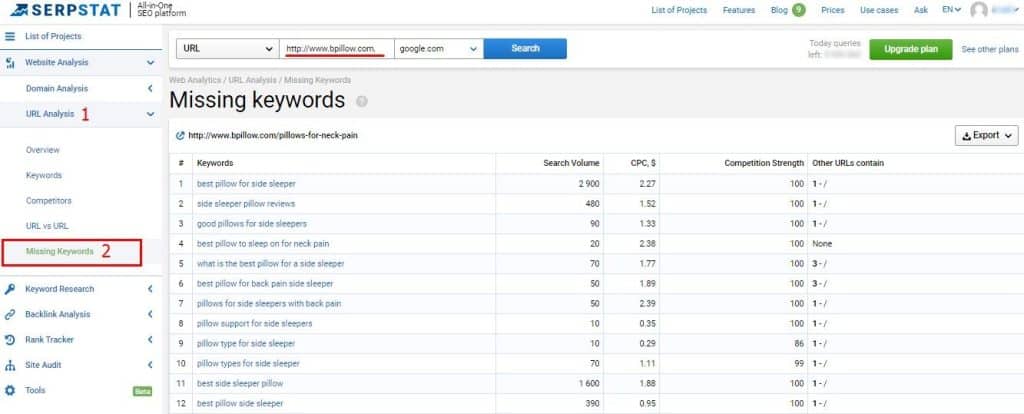
Here we have a large number of keywords which use our competitors, but which are not present in our URL. Remember that this tool shows missed phrases only for SERP top-10.
Also, you probably don’t need all these phrases. Export them to Exel for the detailed analysis, think and filter all useless ones. For example, if you have the commercial project without the blog, remove all “how to” phrases and queries with the wrong geolocation.
There’s also the option of URL vs URL, where you can choose the certain category and compare it by keywords. In the diagram, we see how different it is for the same category of products on different sites.
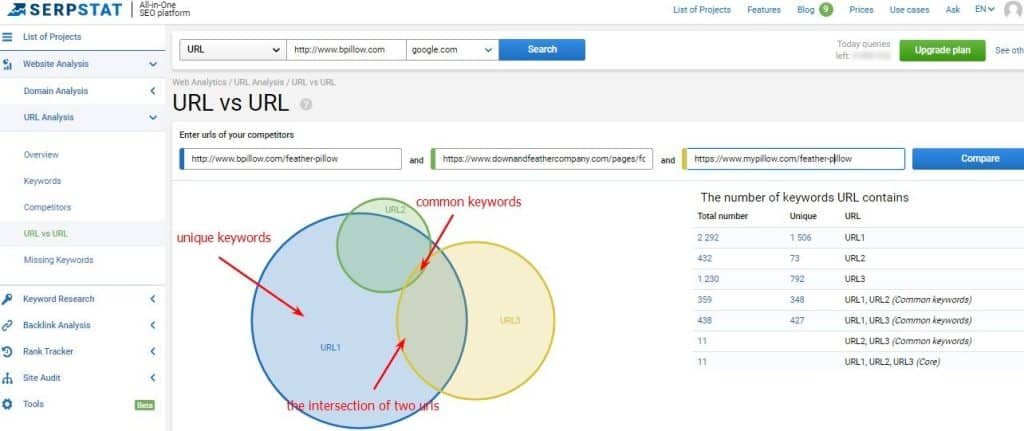
Below the diagram, there is a list of keywords. Thus we can pick up competitors’ keywords and use them in our project.
After that, you can also take a look at the Keyword Difficulty feature at Serpstat. This parameter shows how difficult it is to rank high for the desired keyword. It based on backlink analysis, the presence of domains and URLs with your keyword in title, main pages in the SERP.
Thus, you can filter collected keywords: if KD is high, trying to get into the top using them won’t be worth the effort.
Always think critically when digging into your competitors’ results — even industry leaders go down the wrong path frequently. Don’t be scared of your competitors; you’re the one who’s evaluating them!
Develop Focus Keywords
The next step in your keyword research process is to actually find your focus keywords. I always recommend starting this step with research on your existing keyword rankings and those of your competitors.
Find your existing keyword rankings
If you aren’t already using Google Search Console, this is a good reason to start. It’s a free service that gives you tons of insight on keyword analytics. For this step, go to Google Search Console > Search Traffic > Search Analytics to see which keywords are already earning some results for your site and establish a good starting point for keyword research.
Conduct a competitive keyword gap analysis
Next, you want to find out what your competitors rank for. Even more specifically, you want to know what they rank for that you don’t. One of your content goals should be to fill that gap.
It’s important to note here that your direct competitors may not be the same as your search competitors. You can conduct a Google “related search” to be sure your competitor list is exhaustive. It’s simple: just search for related:yourwebsite.com.
Once you’ve got your complete competitor list, use a content gap or competitor analysis tool to enter their domain and find their ranking keywords. There are lots of tools you can use to do this. I like SEMRush’s Traffic Analytics tool. It requires a paid subscription but you can try it for free.
Round out your list with a keyword generator tool
Finally, you can use SEMRush’s Keyword Magic Tool to enter general keywords you want to rank for and drill down to find related and long tail keywords, understand volume and difficulty, and filter in other ways to find the right keyword list for your business.
Here’s an overview of how the Keyword Magic Tool works:
Create Engaging Headlines (with Keywords in Them)
Why do headlines matter?
Headlines are the most make-or-break element of your blog posts. They’re what shows up on Google SERP pages, and they’re what people use to decide whether to read your content. In fact, 80% of online users never make it past your headline at all. Writing headlines that grab a user’s attention and compel them to click is crucial to driving traffic to your website.

And great headlines? They’re rooted in your keyword research.
To recap: you’ve already written your brief, researched your audience and competitors, and developed your keyword list.
Next, you want to build out a list of 20-30 content themes and topics from your broad and related keyword list. Then it’s time to create your headlines. For MIG clients, we develop about 100 headlines at a time (enough to publish 2x per week for one year).
100 headlines?! You might be thinking that sounds daunting. Actually, it is time consuming and it takes practice. But building out your headline list now has a bunch of benefits you will enjoy later.
A pre-developed list of headlines allows you to:
- Take a holistic view of your content list
- Be intentional about title order and topic coverage
- Stay on track with your publishing schedule
- Assign articles out to writers easily and ahead of time
I recommend putting all of your 100 titles into a content calendar (at MIG we use a simple Google sheet template) where you track your headlines, keywords, and due dates. You can also centralize links to drafts and published articles all in one place.
Below is what the content calendar template we use for our clients looks like. Headlines go in the “Topic/Title” column:
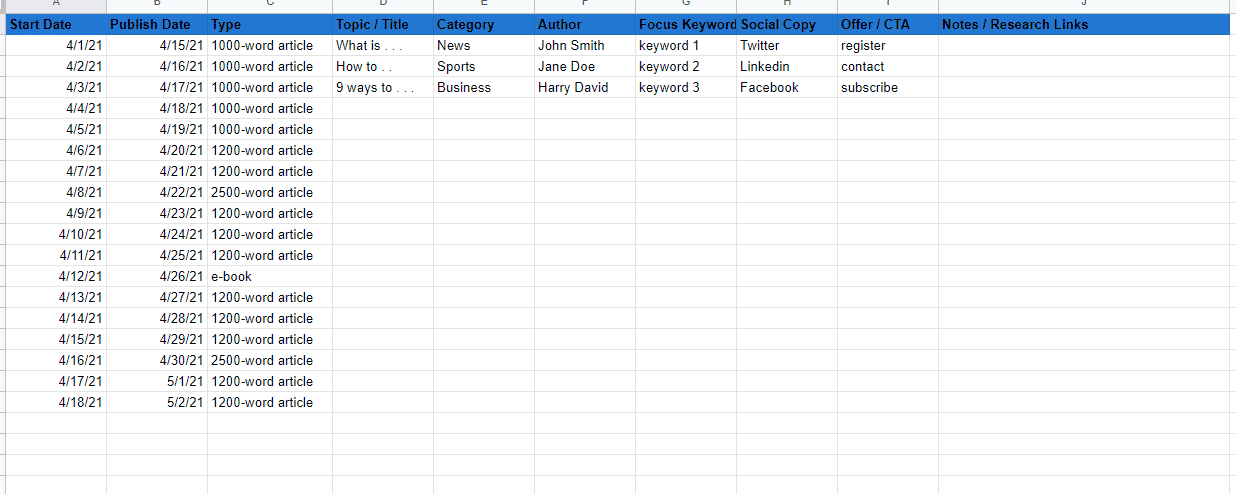
How to write headlines that stand out?
One important question remains: how do you actually write great headlines?
There’s no one right answer, but research has found some trustworthy tips you can incorporate to make your headlines stand out:
- Keep your headlines to 55 characters or less. This ensures your entire title appears on SERPs.
- Use numbers (i.e. “10 Tips for Better X” vs. just “Tips for Better X”).
- Use question words (What, why, how, who, where) to align with search queries.
- Include compelling adjectives
- Show value by telling your audience what they’ll get from reading your article.
Write In-Depth, Engaging Articles
Keyword research can’t accomplish rankings on its own. You need to use your keyword research results to write well-crafted, SEO-optimized articles that both deliver value to the user and catch the attention of search engine crawlers.
You can deep-dive into writing great blog posts in our 20-Step Checklist to Write the Perfect Blog Post. But I’ll share the most important highlights here. They are:
Readability
When people read a blog, they want to feel like they’re reading a blog — not a research paper. Keep your tone conversational, don’t use unnecessary jargon, and skip the fluff in your writing. In other words, get to the point!
And while this should go without saying, I’ll say it: check your grammar. Even just one mistake can turn readers off to your brand!
SEO is key
Follow the basic best practices for SEO, including keyword usage, metadata, link building, text length, use of visual supporting content, and strong calls to action.
Length
Blogs perform best when they’re between 1000-2000 words in length. Be sure your writers always aim for this range when writing your blog articles.
Use your brand voice
Always inject your brand’s voice into your blog posts. Readers want to get to know your brand, and having a personality in your writing makes your content more engaging and enjoyable to read. Include opinions, too — after all, you are establishing expertise in your industry! Don’t shy away from providing commentary on current events relevant to your audience or giving a sure opinion on an important topic.
Track Your Progress Monthly
Last but definitely not least: track your progress. Your keyword strategy does not end with initial keyword research. When you track your progress (we do it monthly for ourselves and our clients), you can continually optimize your strategy by capitalizing on what’s working and solving problems quickly when they arise.
KPIs you definitely want to track:
- Keyword rankings (specifically, rank changes over time)
- Search visibility – how often your domain shows on SERPs for keywords you rank for
- Organic traffic – how many visitors you’re getting from search results
- Top keywords – keywords you’re ranking highest for
Over to You
Ready to launch a keyword research strategy that boosts your content ROI?
MIG’s SEO Blog Writing Service includes the comprehensive keyword research strategy covered in this article. Once it’s complete, our team of writers will deliver you optimized, ready-to-publish content every week for one year (or more!).
Schedule a quick consultation with me to get started!






